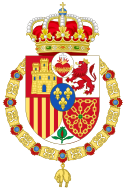Traditionalist Communion facts for kids
Quick facts for kids
Traditionalist Communion
Comunión Tradicionalista
|
|
|---|---|
 |
|
| Leaders | Manuel Fal Conde |
| Founded | 1869 |
| Dissolved | 1937 |
| Merged into | FET y de las JONS |
| Paramilitary wing | Requetés |
| Ideology | Carlism Anti-liberalism Catholic social teaching Integrism Traditionalism Federalism Monarchism Reactionism Foralism |
| Political position | Right-wing |
| Religion | Catholicism |
| Party flag | |
 |
|
The Traditionalist Communion (Spanish: Comunión Tradicionalista, CT) was a political group in Spain. It was one of the names used by the Carlist movement starting in 1869. This group strongly believed in traditional Spanish values, the Catholic Church, and having a specific king.
Contents
How the Traditionalist Communion Formed
In October 1931, Duke Jaime, who was a Carlist leader, passed away. His successor was Alfonso Carlos de Borbón, who was 82 years old. He brought together different Carlist groups. These groups believed that Spain and Catholicism were deeply connected.
The new Carlist party, Comunión Tradicionalista, was formed in 1932. They disagreed with the new government, called the Republic. The Republic wanted to separate the Church and the state, allowing different religions. The Traditionalists did not like this idea at all.
The Group's Beliefs and Actions
The Comunión Tradicionalista was very Catholic and against the government's secular ideas. They even planned for the military to take over. They believed there would be a big fight against groups they saw as anti-Christian.
In October 1934, a Carlist leader named Marcelino Oreja Elósegui died during a revolution. Manuel Fal Condé then took charge. He led young Carlists who wanted to overthrow the Republic. The Carlists began to prepare for an armed conflict with the Republic and its left-wing groups.
Their military group, called the Requeté, grew very strong. It started with small defensive groups in Navarre. But under Manuel Fal Condé, it became a well-trained offensive force. It had 30,000 members, known as "red berets."
The Traditionalist Communion and the Spanish Civil War
When the Spanish Civil War began in 1936, the Traditionalist Communion joined the Nationalists. They shared a belief in Catholicism, even though they had some differences with other Nationalist groups like the Falangists.
General Francisco Franco wanted to unite all Nationalist forces. He announced that all political parties, except for one, were dissolved. Because of this, the Traditionalist Communion stopped existing as a separate party in 1937.
What Carlism Believed In
Carlism is a very traditional political idea. It supports having a king and is strongly Catholic. It started after King Ferdinand VII changed the rules for who would become king next. This meant Don Carlos would no longer be king.
The main ideas of Carlism are "God, Country, and King." Many political parties came from Carlism. One notable party was the Carlist Party of Euskal Herria. This party worked secretly during the fascist government. Later, it ran in elections when Spain became a democracy.
The Legacy of Carlism
After the dictatorship ended, Carlism was still around but was not a strong, unified movement. Some Carlists supported the Francoist government. However, most Carlists had to work secretly because their groups were not allowed.
The Traditionalist Communion was reorganized in the 1950s and 1960s. This happened even though it was illegal in Francoist Spain. Student and worker groups that were not part of the official government party supported this. Prince Carlos Hugo, Duke of Parma also supported them.
In 1970, the Carlist Party was officially created. They decided to change Carlism's ideas towards "self-management socialism." This meant they wanted a monarchy based on socialist ideas, where the people and the royal family worked together. They aimed to be a federal and democratic party for many people.
However, some right-wing Carlists did not agree with these new socialist ideas. These Carlists were led by Prince Sixtus Henry of Bourbon-Parma. In 1975, they re-established the Traditionalist Communion. In 1986, this group joined with two other right-wing Carlist parties. They formed the Traditionalist Carlist Communion. This new party promotes the original, traditional version of Carlism.
See also
 In Spanish: Comunión Tradicionalista para niños
In Spanish: Comunión Tradicionalista para niños

